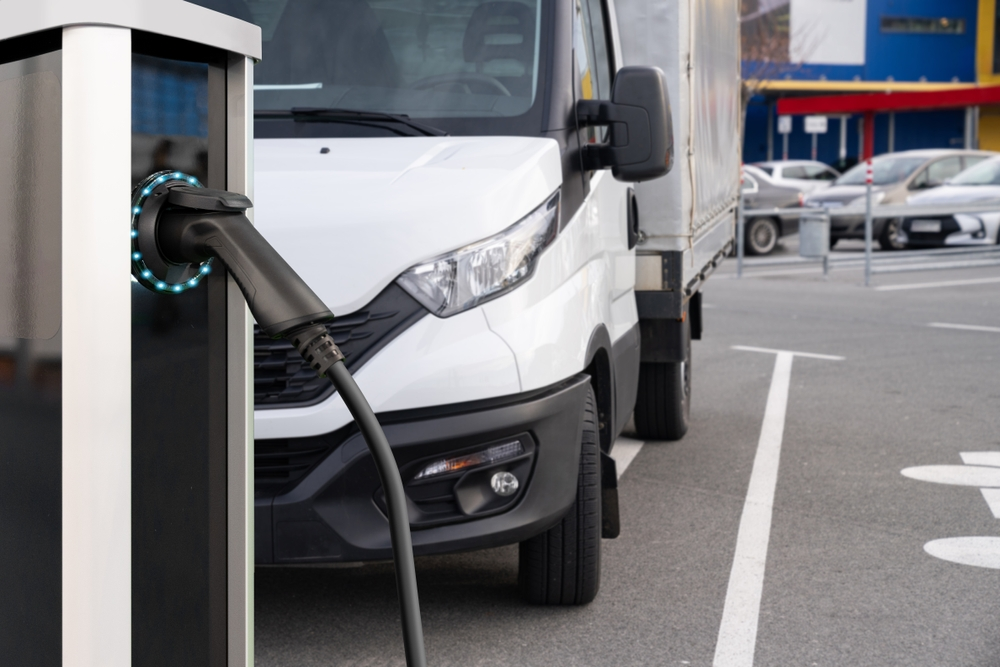Fleet electrification is the process of replacing internal combustion engine (ICE) vehicles in a fleet with electric vehicles (EVs). For many organizations, the shift is driven by tightening emissions regulations, rising fuel costs, and corporate sustainability goals. But what is fleet electrification exactly, and why do operations managers need to address it now?
Why Fleet Electrification Is Moving Faster than Ever
Across North America, environmental regulations are pushing fleets to move away from fossil fuel dependence. The U.S. Environmental Protection Agency is setting stricter vehicle emissions standards, and states such as California have introduced mandates for zero-emission fleet targets.
Public agencies, utilities, and rental operations are already under pressure to adapt.
The financial incentives are also significant. Fuel price volatility has made operating costs harder to predict, and electric fleets offer more stable, often lower, energy expenses.
McKinsey forecasts that by 2030, electrified vehicles could make up more than 60 percent of new light-duty vehicle sales in the U.S., with fleet buyers driving a large portion of this growth. Early adopters have the advantage of securing grants, optimizing charging strategies, and developing operational expertise before competitors.
The New Complexities of Electric Fleet Management
Electrification changes how fleets are scheduled, maintained, and monitored. Route planning must factor in range limitations and charging station locations. Maintenance programs shift focus from engine servicing to battery health. Even small oversights can cause delays, reduce productivity, or increase costs.
For most large fleets, electrification will not happen all at once. Many will operate a mix of electric, hybrid, and ICE vehicles for years. This makes mixed vehicle tracking essential. Without a single system that unifies EV and ICE data, managers face fragmented reports, inconsistent performance tracking, and missed opportunities for cost savings.
For example, Track Star addresses this challenge with a unified platform that combines GPS tracking, telematics, and enterprise asset management. It gives fleet managers a complete operational view covering EVs, hybrids, and traditional vehicles, so they can plan efficiently and respond quickly to performance issues.
Making Mixed Fleets Work in the Real World
During EV adoption for fleets, mixed vehicle tracking ensures that both EVs and ICE vehicles are optimized for their strengths. Dispatchers can assign electric vehicles to routes where charging is accessible and range requirements are manageable, while still keeping conventional vehicles in service for long-haul or heavy-duty assignments.
A unified tracking platform provides the ability to view the status, utilization, and costs of every asset in one place. This includes location data, state of charge for EVs, fuel consumption for ICE vehicles, maintenance schedules, and operational readiness.
By comparing performance across vehicle types, managers can identify underperforming assets, justify replacements, and track emissions reductions for sustainability reporting.

Using Data to Get More Out of Electric Fleets
Accurate data underpins every successful fleet electrification program. Without it, managers risk underestimating charging requirements, overestimating range, or deploying the wrong vehicle for a specific duty cycle.
Telematics data reveals how factors like terrain, load weight, and driver behavior affect EV range. It highlights charging patterns and pinpoints underused infrastructure.
Data also enables detailed cost analysis. By tracking maintenance, energy use, and downtime, fleet managers can calculate the cost per mile for each vehicle type. This makes it easier to demonstrate the return on investment for EV adoption and to fine-tune replacement schedules.
For example, a utility fleet might discover that running auxiliary equipment on EV bucket trucks reduces range more than expected. Track Star’s real-time tracking allows managers to adjust schedules and asset use before these issues impact service.
Compliance and Reporting for Fleet Electrification
Fleet electrification often involves securing public funding or complying with environmental regulations. Many grants and incentives require multi-year performance tracking, including proof of emissions reductions and operational outcomes.
A compliant electric fleet management system should offer automated emissions tracking, greenhouse gas reporting, and customizable compliance reports. These features save time and reduce the risk of errors when meeting federal, state, or municipal requirements.
For public agencies and large private fleets, platforms that meet government-grade compliance standards provide added security and credibility.
Scaling From Pilot Programs to Full Deployment
Most organizations begin fleet electrification with pilot programs. This controlled rollout allows managers to gather operational data, identify challenges, and evaluate how EVs perform in specific roles.
Scaling up introduces new demands. As the number of EVs grows, so does the complexity of charging schedules, infrastructure planning, and maintenance management. A tracking platform designed to scale ensures that fleet managers can expand without having to replace core systems mid-transition. This reduces costs and keeps data consistent.
Technology is also advancing quickly. New EV models, charging technologies, and data protocols emerge every year. A hardware-agnostic tracking system protects your investment by integrating with both current and future assets.
Future-proofing ensures that your platform supports broader operational goals. This includes integration with renewable energy charging solutions, advanced safety systems, and predictive maintenance analytics for both EV and ICE vehicles.
Final Thoughts
Understanding what is fleet electrification and how to track it effectively is essential for any organization preparing for the transition to electric mobility. The process demands careful planning, accurate data, and technology that can handle both electric and conventional assets.
Track Star’s unified GPS tracking, telematics, and enterprise asset management platform is built for complex, compliance-driven operations. It enables organizations to oversee EVs, hybrids, and ICE vehicles from a single system, making electric fleet adoption more efficient, compliant, and cost-effective.
The transition is happening now. Book a demo with Track Star today to see how the platform can help you plan, track, and scale your fleet electrification strategy with confidence.

.png)


